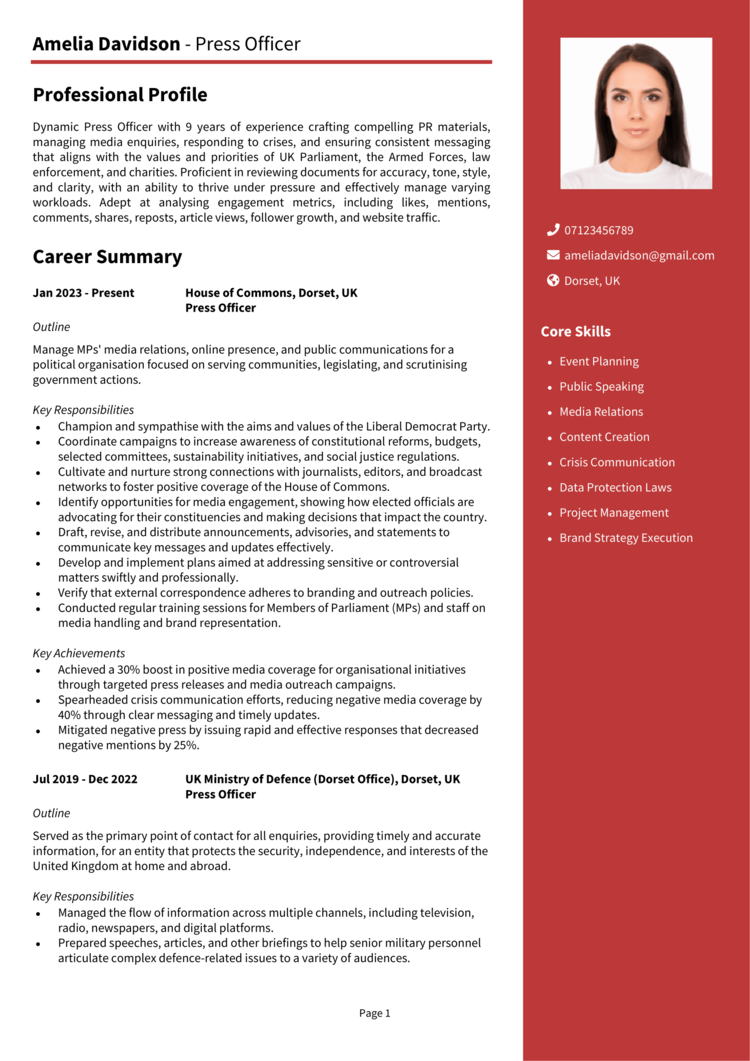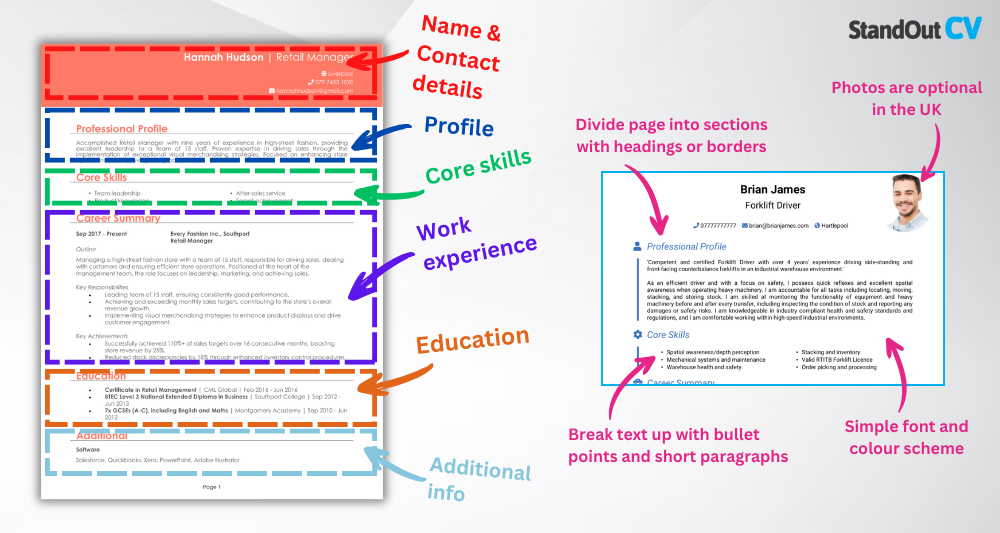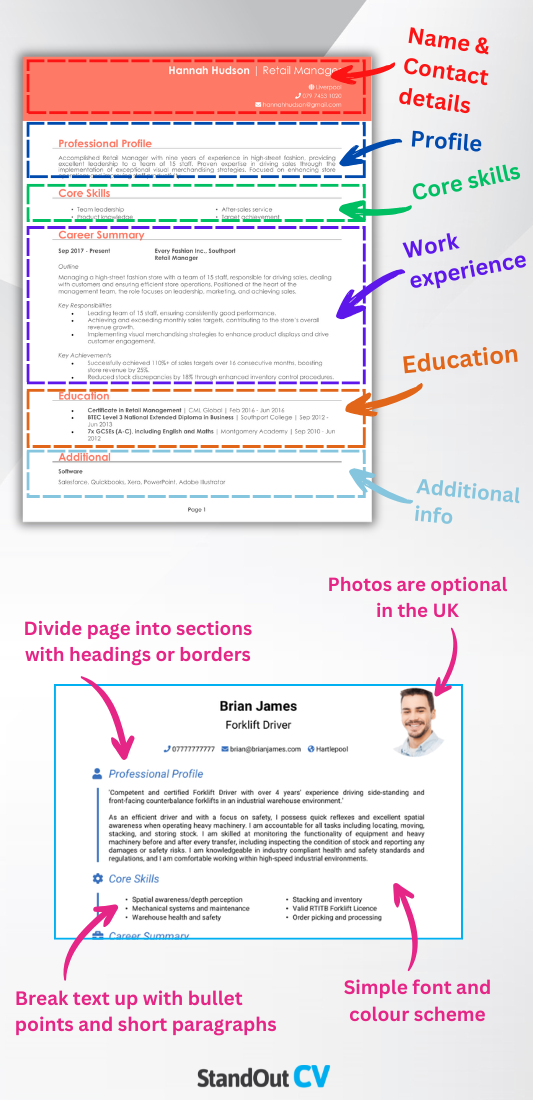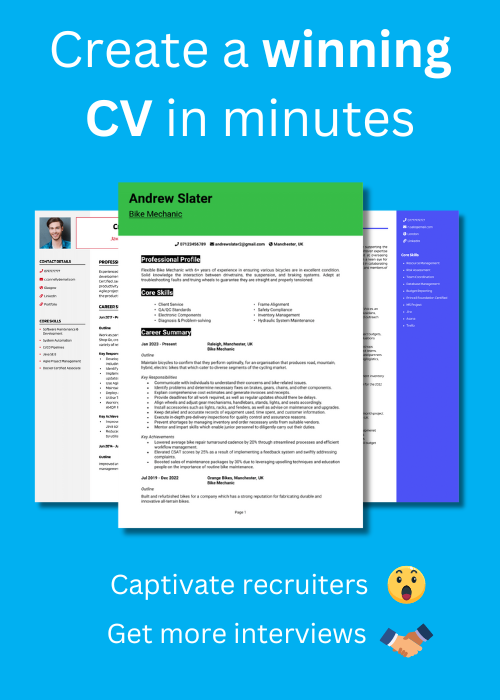Crafting a great message for someone else? Easy. Writing about yourself on a blank CV? Slightly less so.
As a Communications Officer, you know how to shape tone, tailor messages, and control narratives – and that’s exactly the approach you’ll take here. This guide and its 2 Communications Officer CV examples helps you communicate your value clearly and persuasively to help you land your next role.
Communications Officer CV

Press Officer CV

How to write your Communications Officer CV
Discover how to craft a winning Communications Officer CV that lands interviews with this simple step-by-step guide.
You’ve nailed tone of voice for every department but your own. This guide walks you through writing a CV correctly and constructing each section with purpose and clarity.
From planning the layout to writing standout accomplishments, you’ll learn how to frame your experience so that hiring managers see exactly why you’re the right person for the job.
How to structure and format your Communications Officer CV


A good CV isn’t just about what you say – it’s about how clearly you say it. When employers scan your application, they want to see core skills, relevant experience, and key outcomes presented in a way that’s quick and easy to understand. Your CV is going to need to be structured to make it all clear.
Here’s the layout to follow:
- Name and contact details – These contact information sit at the top to provide easy access for prospective employers. Adding a photo is optional.
- Profile – Hook the recruiter right away by stating the value you’ll bring their company.
- Core skills – State your best qualities at a quick glance.
- Work experience – List your previous job titles from newest to oldest.
- Education – Show off your academic record and qualifications.
- Additional info – Include anything from your hobbies and interests to the languages you speak – these are all totally optional.
Cluttered CVs get the same treatment as spam emails – ignored. Use bullet points to break up the text and highlight your contributions clearly. Stick to a clean, readable font and divide your CV into clear sections with consistent formatting. Keep the overall length to two pages or less – anything longer risks losing the reader’s attention. A polished format which follows these tips sends a clear message: this candidate knows how to communicate professionally.
How to write a Communications Officer CV profile


This section is your written elevator pitch. It’s the first thing a hiring manager will read – so make it count. Your CV profile should briefly summarise who you are, what kind of organisations you’ve worked for, and the communication impact you’ve made in previous roles.
Focus not just on what you’ve done, but on the results you’ve delivered – and tailor the tone of your profile to match the type of employer.
Communications Officer CV profile examples
Profile 1
Experienced Communications Officer with over nine years supporting internal and external messaging for government agencies and not-for-profit organisations. Skilled at developing press releases, managing stakeholder communications, and crafting high-impact content across digital and traditional channels. Adept at aligning communications with strategic objectives.
Profile 2
Strategic Communications Officer with six years of experience across education and healthcare sectors. Confident managing campaigns, building media relationships, and driving employee engagement through compelling content. Strong understanding of CMS platforms, social media strategy, and brand governance.
Profile 3
Versatile Communications Officer with four years of experience in the private sector, delivering internal communications, marketing collateral, and PR materials. Known for clear, audience-focused writing and strong collaboration with creative and leadership teams to ensure consistent messaging across all touchpoints.
Details to put in your Communications Officer CV profile
Include the following:
- Where you worked – Mention the types of organisations you’ve worked in, such as government departments, charities, agencies, or corporate settings, to provide context for your experience.
- Your top qualifications – Include any degrees, diplomas, or certifications in communications, journalism, or public relations that support your credibility.
- Essential skills – Touch on your ability to manage messaging, engage audiences, and coordinate across departments or with external media.
- Sectors or formats – Briefly note any experience with press, internal comms, social media, or crisis communication, if relevant to your role.
- Value delivered – Explain how your work supported organisational goals – for example, increasing engagement, improving reputation, or streamlining internal messaging.
What to include in the core skills section of your CV


In communications, employers want clarity – so don’t pad this section with vague claims or soft skills. Instead, use this space to highlight technical strengths and areas of specialism that match the job description.
Think in terms of tangible CV skills: campaign coordination, stakeholder engagement, drafting for print and digital, media monitoring, or crisis communications. If you’ve worked with specific CMS platforms or analytics tools, this is also a good place to mention them. Keep the focus on skills that prove you can deliver targeted, strategic messaging with measurable impact.
What are the most important skills for a Communications Officer CV?
- Press Release Writing and Distribution – Crafting and issuing press releases to share key announcements and maintain positive media relations.
- Social Media Management – Creating and scheduling content across social platforms, monitoring engagement, and responding to public interactions.
- Internal Communications Support – Developing newsletters, intranet updates, and staff announcements to keep internal stakeholders informed.
- Media Monitoring and Analysis – Tracking media coverage, public sentiment, and communication KPIs to assess campaign impact.
- Content Development for Digital and Print – Writing blog posts, articles, brochures, and web copy that align with brand messaging.
- Event Communication Support – Coordinating communication materials and promotion for events, conferences, and public campaigns.
- Stakeholder Communication – Liaising with partners, funders, and community members to share information and build trust.
- Brand Consistency Oversight – Ensuring all communications follow brand guidelines and reflect organisational values and tone.
- Crisis Communication Assistance – Supporting message drafting and coordination during urgent or sensitive situations.
- Website and Intranet Updates – Managing web content and ensuring information remains current, relevant, and accessible.
How to write a strong work experience section for your CV


Your work experience isn’t just a list of tasks – it’s more like your PR campaign for yourself. Think of each job as a case study – what was the message, who was the audience, what was the result?
List your previous roles in reverse chronological order. Start each entry with a short paragraph explaining the organisation, your position, and the focus of your role. Follow this with bullet points that detail your responsibilities and achievements.
Mention the formats you worked in (press releases, newsletters, digital content), who you collaborated with, and what outcomes you achieved. Where possible, include metrics such as engagement rates, reach, or stakeholder satisfaction.
The best way to structure job entries on your CV

- Outline – Provide context about the organisation, your role, and where you fit within the wider communications or marketing team.
- Responsibilities – Use action words like “drafted” and “coordinated.” For example: “drafted weekly internal newsletters for 3,000+ employees” or “coordinated public health campaign messaging across digital and radio channels.” Mention tools and processes where relevant.
- Achievements – Show how your work made a difference – increased engagement, improved sentiment, successful campaign launches, or crisis management handled smoothly. Quantify when possible.
Sample jobs for Communications Officers
Communications Officer | Kelbridge Borough Council
Outline
Provided internal and public-facing communications for a local authority, supporting consultation campaigns, service updates, and media handling across multiple departments.
Responsibilities
- Drafted press releases, social media posts, and newsletters for residents
- Managed updates to the council website using CMS and ensured accessibility compliance
- Handled press enquiries and issued official responses on behalf of departments
- Created materials to support community engagement events and consultations
- Liaised with design teams to produce branded visuals and reports
Achievements
- Improved resident engagement on digital platforms by 45% in one year
- Supported rollout of a borough-wide recycling campaign that reached over 80,000 people
- Reduced turnaround time for press responses by 30% through new process guidelines
Communications Officer | Maythorne Health Trust
Outline
Delivered strategic communications for a regional NHS Trust, ensuring clarity of messaging across patient updates, staff engagement, and stakeholder materials.
Responsibilities
- Wrote patient letters, service updates, and trust-wide announcements
- Managed internal newsletter and intranet content for 2,000+ staff
- Supported communications planning for clinical campaigns and trust initiatives
- Worked with clinicians to translate technical updates into public-friendly language
- Monitored media coverage and prepared reports for executive leadership
Achievements
- Increased staff newsletter open rates from 41% to 66% over 9 months
- Led patient communications during an outpatient services restructure with minimal complaints
- Developed a media briefing pack adopted across all NHS sites in the region
Communications Officer | Velnex Logistics Ltd
Outline
Oversaw communications and PR for a national logistics provider, ensuring consistency across internal messaging, corporate materials, and brand representation.
Responsibilities
- Produced internal comms materials for HR, health and safety, and executive updates
- Wrote and edited content for website, LinkedIn, and trade publications
- Collaborated with external PR agency to manage reputation and press outreach
- Organised internal campaigns to promote training and operational change
- Maintained comms calendar and monitored effectiveness of digital content
Achievements
- Reduced internal email volume by 25% by streamlining weekly staff updates
- Helped secure national trade award through strong campaign coverage
- Delivered consistent branding across all communications materials during company rebrand
How to list your educational history


In communications roles, a relevant qualification often provides a strong foundation – especially if you’re early in your career. Whether you studied journalism, public relations, marketing, or media, this section should reflect the academic preparation that supports your practical skillset.
Start with your most recent or highest-level education. You can also mention short courses or certifications in copywriting, SEO, or internal communications. If you’ve worked in the field for a while, keep this section brief – but if you’re starting out, feel free to expand slightly on key projects or modules.
What are the best qualifications for a Communications Officer CV?
- BA in Communications, Journalism, or Media Studies – Strong academic foundation for a communications-focused career
- Chartered Institute of Public Relations (CIPR) Certificate – Industry-recognised qualification for strategic and practical skills
- PRINCE2 Foundation or AgilePM (if relevant) – Useful for project-based communications roles
- Google Digital Garage or HubSpot Content Marketing Certification – Demonstrates modern content and platform knowledge
- Professional Writing or Copywriting Diplomas – Enhances credibility in writing-intensive roles





